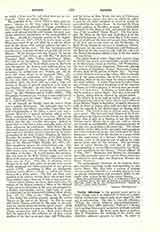

Votive Offerings is the general name given to those things vowed or dedicated to God, or a saint, and in consequence looked upon as set apart by this act of consecration. The idea is very old (Dhorme, “Choix des textes religeux assyro-babyloniens”, XXXVII, Paris, 1907; Aristotle, “Politics”, VII, xii), for it springs from man’s instinctive attitude towards the higher powers. He looks upon them as controlling by Providence the working of the world, and therefore addresses prayers to them. In order to make his appeal the more acceptable he offers some gift, whether on behalf of the living or the dead, to the offended deity. Hence undoubtedly springs (though with it is coupled the vague notion of the passage to the next life as of a long journey) the custom of surrounding the buried dead with their most valued possessions and favorite wives (Fraser, “Pausanias”, II, 173; Lyall, “Asiatic Studies”, II, 301). But it has also happened that the practice, based on the true theological concept of religion as a part of justice (do ut des), comes of adorning shrines with various objects of gratitude (Cicero, “De deorum natura”, III, xxxvii). in this more ordinary sense of the word votive offerings can be divided into: (a) things vowed to God or the saints in some trouble or crisis of life; (b) things presented in gratitude for a recovery or deliverance without having been previously promised.
Naturally these votive offerings constitute an extremely varied list. The most common are those which represent the person to whom the favor has been accorded, or the thing that has benefitted under the miracle, or some representation of the actual Divine interposition. Thus, for example, on the day of his marriage, Henry III of England had a golden statue of his queen made and placed on the shrine of St. Edward at Westminster (Wall, “Shrines of British Saints”, 228) and a full-length figure of Duke Alessandro de’ Medici was moulded in wax for the Church of the Annunziata at Florence by Benvenuto Cellini (King, “Sketches and Studies”, 259). Again, the offering of a falcon in wax at the shrine of St. Wulstan by Edward I, when, by the intercession of that saint, his favorite bird had been cured (Wall, 141), and of the tail of a peacock at Evesham by an old lady whose pet had recovered through the invocation of Simon de Montfort (King, 259), are instances of the same custom. At Boulogne and elsewhere can be seen the model ships offered as ex-votos after deliverance from shipwreck, such as we read of Edward III leaving at the tomb of his father, or such as the Navicella at Rome, a copy made under Leo X of a pagan votive offering to Jupiter Redux (Hare, “Walks in Rome“, I, London, 1900, 231). So, too, sometimes a wax taper of the height of the sufferer, or even of his dimensions was brought or sent to be burnt where the cure or favor was implored. Of the pictures of miracles as votive offerings there seems no end (“Archaeologia”, XLIX, London, 1886, 243-300); their number became at times an inconvenience (Acta SS., XIV, May, I, 354), like the numerous crutches, etc., in the grotto at Lourdes or S. Nicolb at Verona, or SS. Giovanni e Paolo at Venice. There is, moreover, the parallel of the golden boils and blains placed by Divine command within the Ark (I Kings, vi, 11).
We also read of money and valuables being offered, as the famous regale of France, which, described indifferently as a diamond and a ruby, adorned the tomb of St. Thomas Becket at Canterbury. Often also a trophy of victory (King, 256-7), the banner of a defeated foe (“Itinerarium Regis Ricardi”, in “Rolls Series“, I, London, 1864, 446), or his sword (I Kings, xxi, 9), or even that of the victor (as Roland’s at Rocamadour, or Athelstan’s after Brunanburgh at the shrine of St. John of Beverley, or as the sacred Stone of Destiny offered by Edward I at the tomb of his namesake the Confessor, after his defeat of the Scotch), or some symbol of office and dignity, as the crowns presented by King Canute at Bury St. Edmunds and elsewhere, or lastly some masterpiece of literature or art, as Erasmus hung up Greek verses at the shrine of Our Lady at Walsingham (“Colloquies”, II, London, 1878, 19).
BEDE JARRETT

